
Views and better engagement rates are a must-have for digital brands in today’s digital world. If you want to know how to do YouTube SEO marketing or are looking for YouTube video tips and SEO best practices, this guide has got you covered.
In the simplest of words, appearing on top of the search results on YouTube and Google will gather more views for your video, and this blog will show you how to do so with carefully curated tips to get more views on YouTube.
Once you understand YouTube’s SEO best practices, you will be better equipped to optimize your videos for better rankings.

How to Grow Your YouTube Channel
Ultimately, every creator wants views on their YouTube channel. To ensure you get views consistently and attract new visitors to your channel, you must learn how to grow your channel’s value and subscribers.
This includes promoting your content to boost its visibility across the Internet and acquiring more subscribers by answering relevant questions to their search queries. Quality content paired with YouTube video tips can help creators rise to the rank of top influencers.
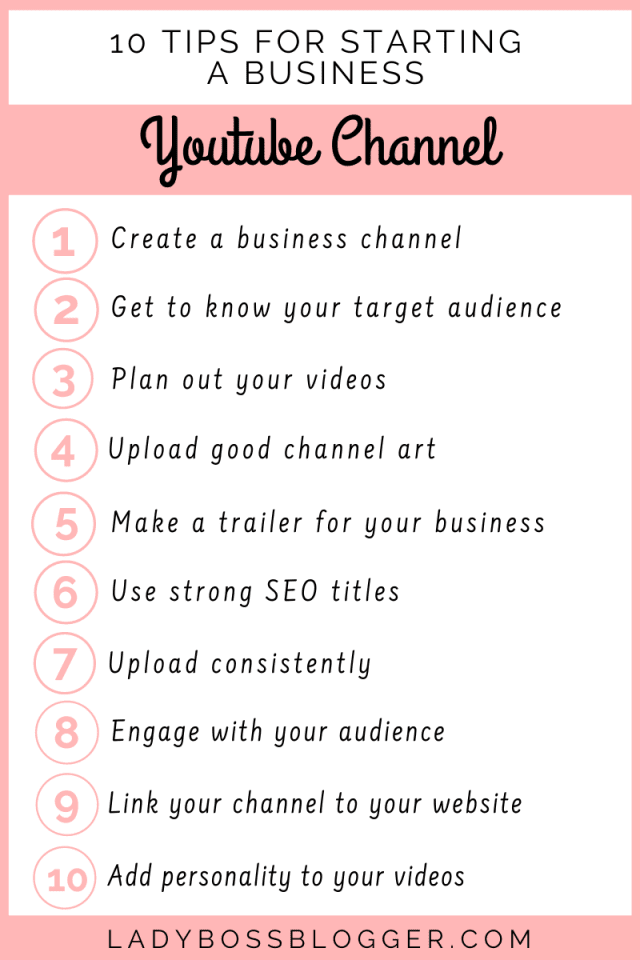
So, how do you grow your YouTube channel? Here are some tips.
- Upload 720p or higher resolution videos
- Use unique thumbnails that urge users to click
- Ensure zero lag in your video content
- A catchy and creative title; this must include YouTube keyword research
- Good descriptions; follow our YouTube SEO tips
- A compelling intro; first impression matters
- Be grammatically accurate; people like credible sources
- Use video tags wisely; don’t worry, we’ll show you how!
- Use a self-explanatory and fun YouTube channel background image
- Engage with your community; don’t leave commenters hanging
- Be open-minded to feedback; sometimes people may get out of hand, but try and be mature about it
YouTube SEO Best Practices
1. Upload high-quality videos
The nature of videos is changing. Most viewers prefer to engage with quality content with increased access to smartphones with good cameras. If you want to grow your YouTube channel, start by ensuring that the video resolution is good and the content is immediately relatable to your target audience and adheres to the chosen topic.
2. Patience is indispensable for creators
You won’t necessarily rack up on views in the first few weeks. The key is to start on the right note and continuously produce quality content that engages people and maintains consistency. That’s how you become a reputed content source, leading to more subscribers and shares on the Internet.
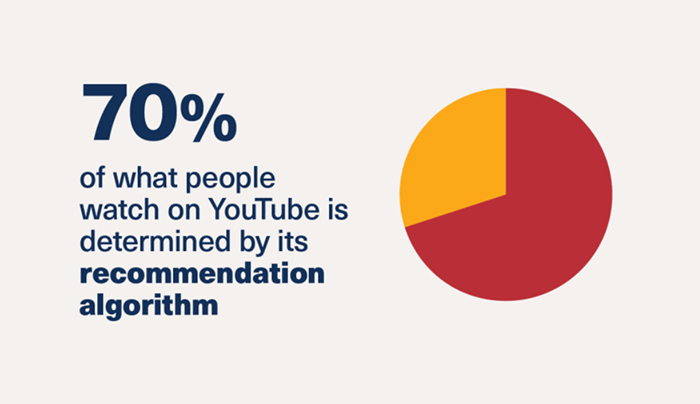
You can also go the extra mile to promote your videos on other channels. But, dedicate yourself patiently to results that will surely follow in due time. If you have a creative idea that you want to share with the world, your YouTube SEO will ensure you gain more visibility.
3. Understand and apply SEO
YouTube is the second-largest search engine in the world, right after Google. And the best part is that it relies solely on video content. It’s the second most visited page on the Internet, and for a good reason.
To ensure that these people also visit your page and view your videos employ evidence-based YouTube SEO best practices.
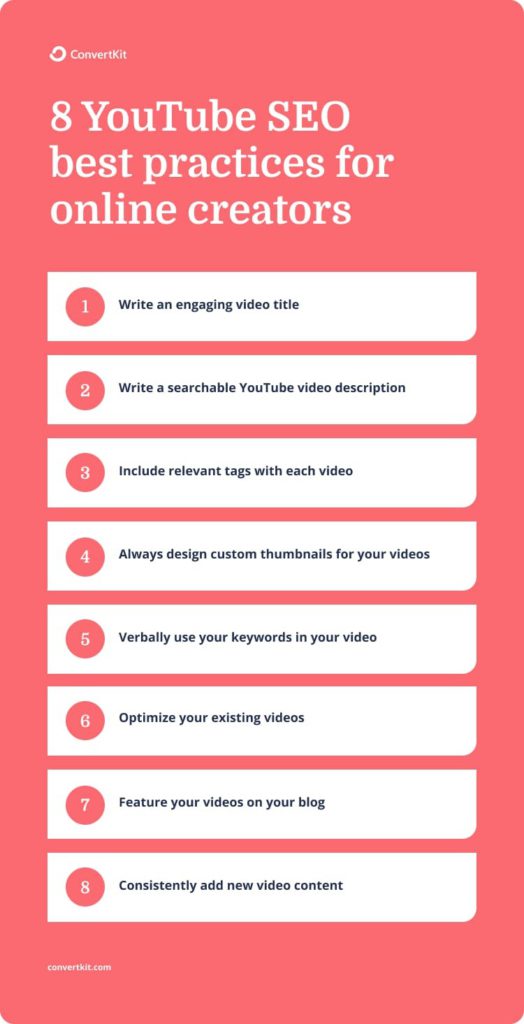
4. Use the right keywords in your channel
Keywords are the backbone of SEO. If you’re familiar with blogging, you’ll know how much keyword research can improve your page rankings. The same applies to YouTube SEO. Thorough keyword research and strategy will position your YouTube videos on top of the results.
In the “About” section of your YouTube channel, you can clearly articulate the purpose of your channel to the visitor. If you’re sharing content about online courses, words like e-learning, skilling, free courses, and online education can improve your channel’s SEO.
Write a 200-300 word introduction about your channel’s primary focus and key topics to educate the viewers and nurture their interests.
The YouTube algorithm gives extreme importance to a page’s metadata, and your channel keywords are responsible for complementing the ranking algorithm. You can add a one- or two-paragraph long description of your channel by heading over to “Settings” in your channel’s “Creator Studio” once you’ve logged in. Using tools like VidIQ or Google Keyword Planner, you can find the right keyword to plan and perform SEO.
5. Video keywords are all-important
Video keywords are usually long-tail phrases on YouTube, much like how a searcher would type into the search bar. You can use video keywords to rank high in different areas and generate traffic to your channel.
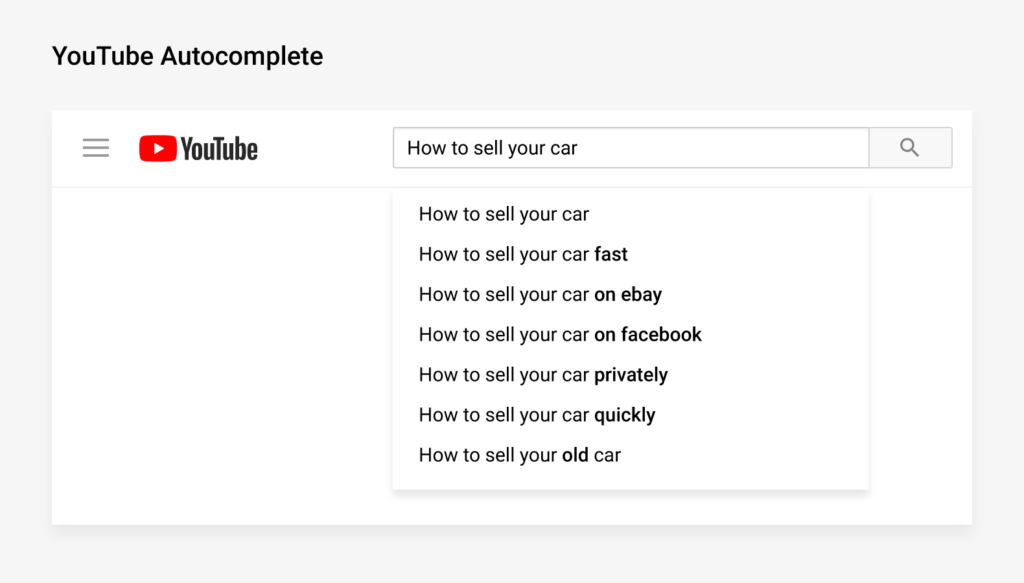
Use the autosuggest feature to help you by typing your keyword into the search bar and observing the results. If you want more suggestions, use _ (underscore) to get more ideas in the form of suggestions for the input keyword.
Your video keywords should be specific phrases from a general idea of the search intent you’re looking to respond to with your content. Whether you choose general or more specific long-tail keywords, it’s always a good idea to check the competition for keywords and ensure your videos are of good quality when they go live.
An effective browser extension called the MozBar Chrome Extention lets you do keyword research with insights about the other competing videos for any given keyword. This tool can be easily downloaded and installed into your Chrome browser. This research helps when a top result on YouTube has more page authority, and you are expected to create better videos by selecting niche phrases that address the topic.
6. Use captivating video titles
From among the YouTube SEO best practices, the significant focus is on creating a compelling title that is well-thought-out and relevant to users’ search intent.
The title and thumbnail are the main reasons people click to view your video from the search results page. Once again, just like a blog or website, your metadata plays a vital role in complementing the video title, too.
A video title gives search engines an instant introduction to your content and YouTube viewers. A good title should make people want to click because it looks like they have some value. In most cases, shorter titles are the best performers because they are displayed easily among results and quickly read. In some cases, gadgets, browsers, and apps restrict video titles to maybe 6 to 8 words, or even less.
7. Focus on the video descriptions
Just like YouTube video titles, descriptions play a vital role in improving your SEO value and, thereby, your ranking.
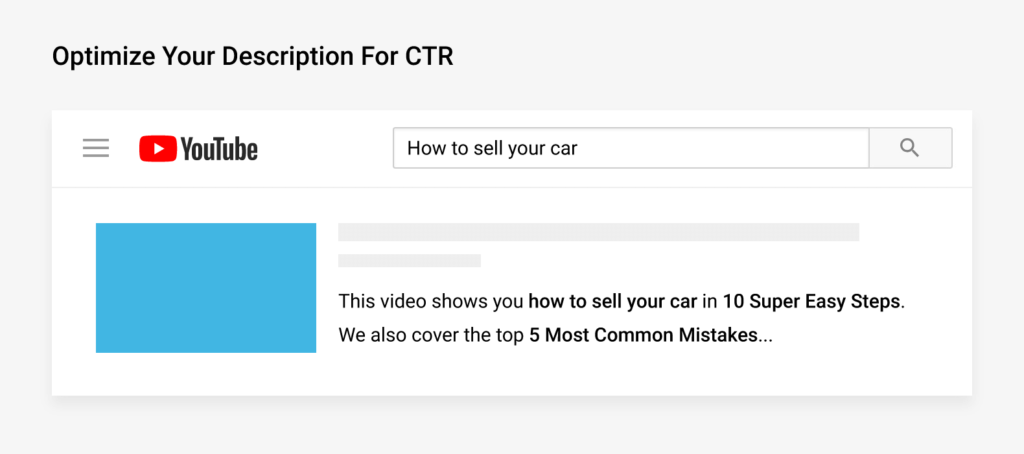
YouTube and Google consider video descriptions a top-ranking factor because the search results require the description to determine the nature of your video content. If you don’t fill out the description with some thoughtful words and links to other pages or related videos, you’re missing out on a massive chunk of the traffic.
Writing brief but keyword-rich YouTube video descriptions is a pro YouTube SEO tip to follow. The description is another area where your keyword planning and competitor research comes in handy.
8. Include video tags
Tags comprise one- or two-word descriptions of the category that your YouTube video falls under. Video tags are a way of enhancing the value of keywords used in your video title and description. Hence, they play a vital role.
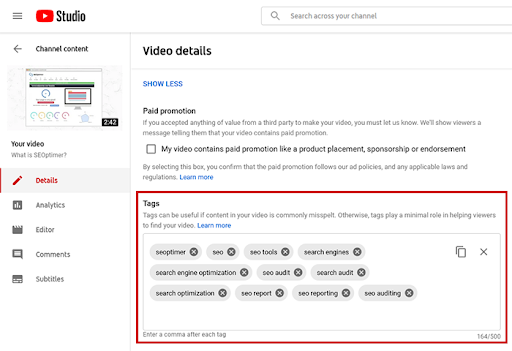
For example, YouTube video tags help viewers identify the type of content they want to view. Tags are primarily keywords that should be chosen after understanding the typical words people enter into YouTube search to find your type of content.
If you’re creating educational videos, you can use tags like “learn a new skill” or “free courses for beginners.”
9. Have a linking strategy
Another important SEO tip to get more YouTube views is to have a linking strategy. You can position your social media links, website, third-party content, references, or a link to your personal blog in the description. Just be sure to use the right keywords that make it easy for the algorithm to rank you.
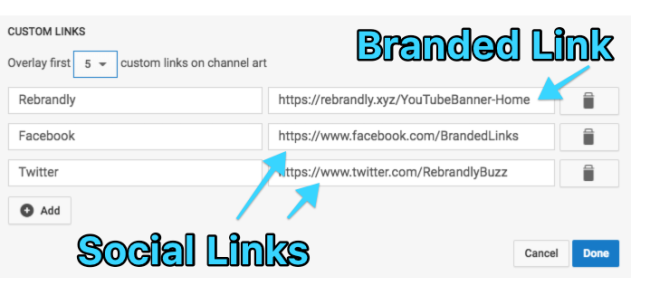
You create a network of content surrounding your main video by inserting links into your video descriptions. This improves the page’s value, especially as more people click through to learn more about your shared resources.
10. Don’t forget thumbnails.
YouTube video thumbnails are not really a ranking factor, but creating good templates and using visual elements are pro tips to get more views on YouTube.
That’s because a well-designed video thumbnail makes people want to know more when they see the video thumbnail on social media or the search results page. The visual elements of text and images influence their decision of whether to click to view or move on to the next result.
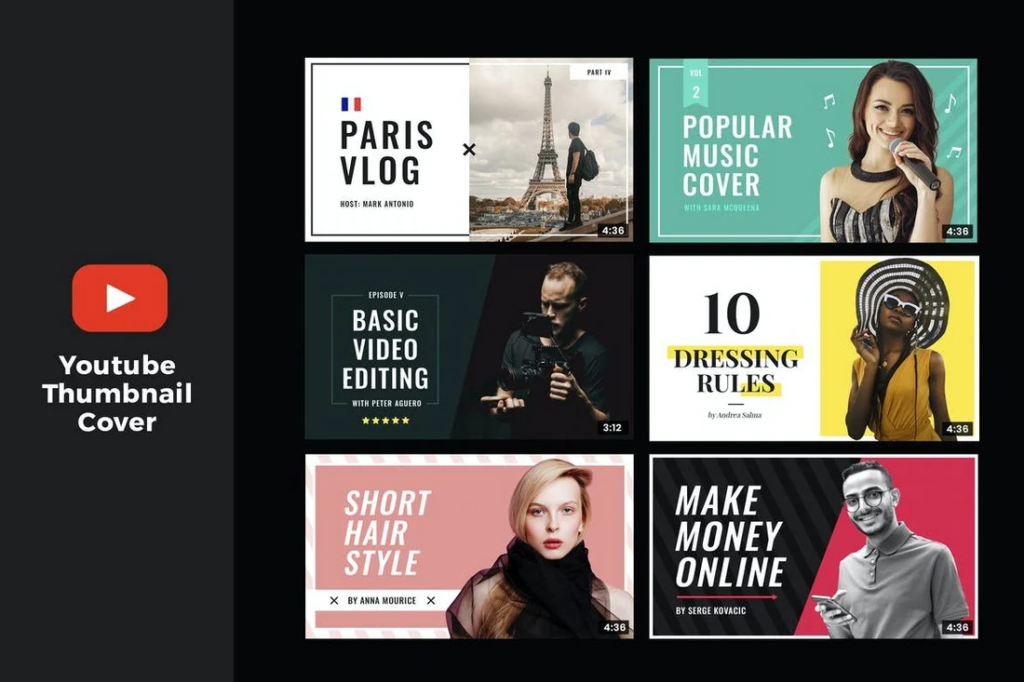
The most significant part of learning how to do YouTube SEO marketing is understanding that visual impact is the key driving factor of YouTube engagement. After all, searchers are looking for visual content in the form of videos.
By adding creative thumbnails, you improve your chances of evoking the viewers’ interest and getting them to view your video. From there, it’s all about how engaging your video channel is to determine whether they subscribe or not.
In the End
With these YouTube SEO tips and YouTube SEO best practices, we hope you gain a fair understanding of how to do YouTube SEO marketing and improve your overall ranking to attract more traffic and make your presence felt.
Here’s an equation to summarize the importance of SEO for your YouTube videos.
Better SEO = better visibility X better quality = better engagement X more views = more revenue.
If you want to revise the basics and learn more about the fundamentals of video content, read the blog The Basics of Video Content Marketing for some comprehensive insights.
Also, browse our FAQs section for some excellent insights into the YouTube platform.
Key Takeaways
- You can research well and optimize your YouTube videos using on-page and off-page SEO, combined with some interactive tools mentioned in this guide. Furthermore, your content’s creative ideation and consistent quality will help you grow your channel steadily.
- By understanding the key ranking factors like video title, video length, descriptions, tags, keywords, and metadata, you will know how to do YouTube SEO marketing with every new publication.
- Be sure to leverage thumbnails for improved clicks. Feel free to start a blog of your own, where your viewers can learn more about your creative pursuit and the main inspiration behind your videos.
- Everything on the Internet is about building credibility and generating engagement. So, apply your most creative ideas.
- By creating relevant content that matches the users’ search intent, you can kickstart your career as a YouTuber or build an online presence for your business and product’s visibility.

FAQs
YouTube Analytics, YouTube Autosuggest, Google Keyword Planner, VidIQ, and RankTracker are free YouTube SEO tools.
Video length, keywords, title, description, tags, and engagement are the core factors that influence your YouTube video rank.
Social sharing is a great YouTube SEO tip you can leverage to drive traffic from multiple platforms. Maintaining a WordPress blog or a Facebook handle is an example of how you can leverage social sharing for your YouTube videos.
YouTube video length depends on whether your account is verified or not. If you aren’t verified, the length of your YouTube video can be up to 15 minutes or less. However, if you are a verified creator, you can post videos on YouTube up to 12 hours long – as long as the maximum size is 128 GB.
No. While they are both owned by Alphabet Inc., the two platforms have distinctively different ranking factors. They both run on keywords and engagement in terms of the average time users spent on a page, while YouTube also considers the engagement in terms of likes, dislikes, comments, etc., like social media.
Latest Blogs
Explore how Google’s 2025 AI search updates triggered ranking chaos. Learn actionable strategies to adapt your SEO for AI Overviews, zero-click searches, and SERP volatility. Stay ahead now.
Learn how to rank on AI search engines like ChatGPT, Perplexity, and Gemini by optimizing your content for authority, structure, and relevance. Stay ahead in AI-driven search with this strategic guide.
Explore the best healthcare SEO services for your medical practice. Improve online visibility and effectively reach more patients in need of your services.
Get your hands on the latest news!
Similar Posts

Artificial Intelligence
6 mins read
The Role of AI in Digital Marketing: AI Article Generators Transforming Content Creation

Artificial Intelligence
4 mins read
How AI Content Creator Is Shaping the Future of Digital Content

Digital Marketing
3 mins read